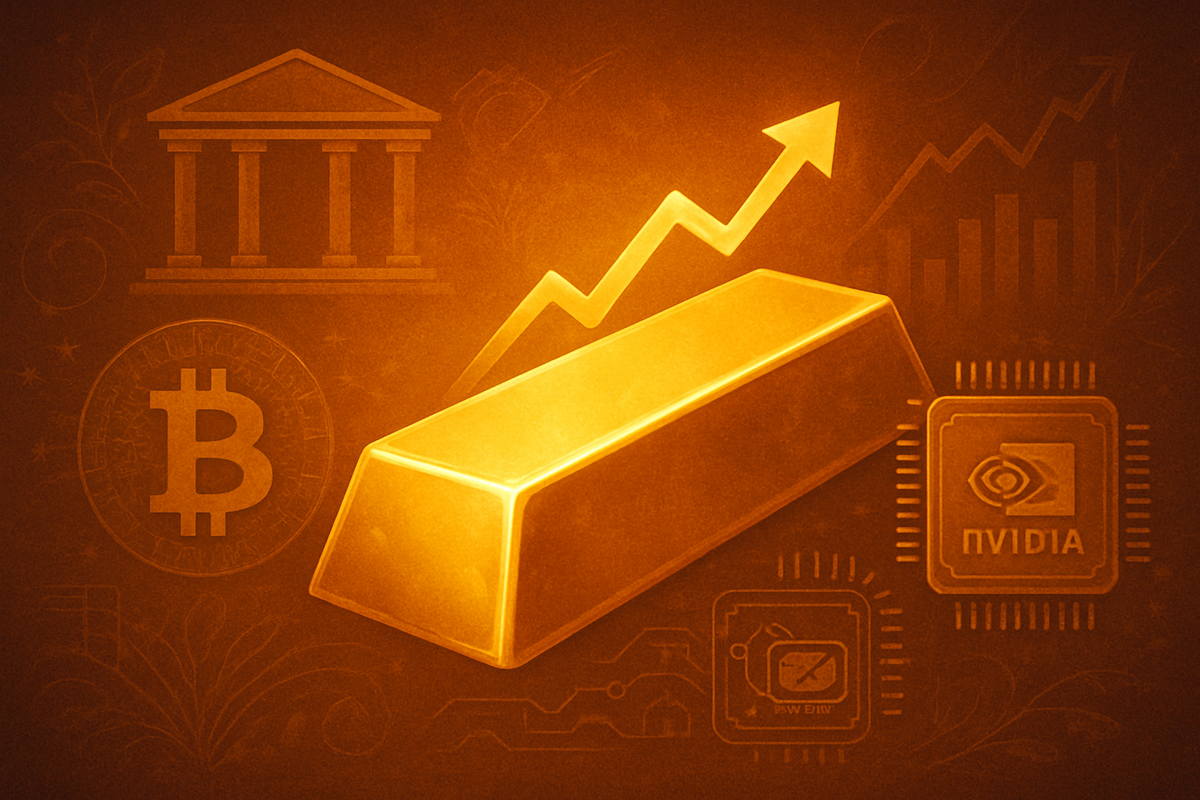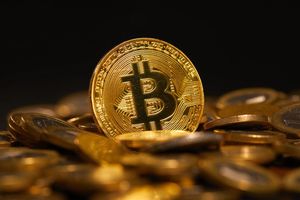
October 17, 2025 – In a monumental shift for global financial markets, gold has officially achieved a historic global valuation, soaring past the $30 trillion mark. This unprecedented milestone firmly cements gold's enduring status as a premier safe-haven asset and a dominant force in the global economy, significantly dwarfing the market capitalizations of both the burgeoning cryptocurrency titan, Bitcoin, and the artificial intelligence powerhouse, Nvidia (NASDAQ: NVDA).
This remarkable achievement underscores a profound reallocation of capital and a renewed trust in tangible assets amidst a landscape of persistent geopolitical uncertainties, inflationary pressures, and a search for stable stores of value. The immediate implications are clear: gold is not just holding its own; it is asserting its preeminence, challenging the narratives that have often favored tech growth and digital currencies in recent years.
The Ascent to $30 Trillion: A Confluence of Powerful Drivers
Gold's journey to a $30 trillion valuation has been propelled by a powerful confluence of factors, reflecting a broad-based shift in investor sentiment and institutional strategy. The estimated global market capitalization for gold now stands at approximately $29.484 trillion, with some reports confirming it has touched the $30 trillion threshold. This valuation is derived from a robust average price of gold, ranging from $4,241 to $4,357 per ounce, combined with an estimated 216,265 to 218,000 metric tonnes of above-ground gold reserves.
This historic valuation not only surpasses Bitcoin's (approximately $2.1 trillion to $2.25 trillion) by a factor of over 14 but also significantly outpaces Nvidia's market capitalization of roughly $4.37 trillion to $4.479 trillion. In fact, gold's market value now exceeds the combined market capitalization of the "Magnificent 7" tech giants, which collectively hover around $20 trillion. The timeline leading to this moment has been characterized by consistent inflows into gold, driven by a growing apprehension towards economic instability and a global search for reliable hedges against inflation and currency debasement. Key players in this surge include central banks, institutional investors, and a resurgent interest from retail markets, particularly in Asia. The initial market reaction has been one of validation for gold bugs and a re-evaluation for those who had previously dismissed the precious metal as an outdated investment.
Central Banks, ETFs, and India: The Pillars of Demand
The bedrock of gold's historic rally can be attributed to three primary drivers: aggressive central bank accumulation, sustained interest from Exchange Traded Funds (ETFs), and soaring demand from major economies like India.
Central banks globally have been net buyers of gold for several consecutive years, viewing it as a crucial component of their reserve assets to diversify away from traditional fiat currencies and hedge against geopolitical risks. This strategic buying by sovereign entities signals a profound lack of confidence in the stability of the global financial system and a concerted effort to bolster national financial security. This institutional endorsement provides a strong floor for gold prices and sends a powerful signal to the broader market about the metal's intrinsic value.
Simultaneously, gold-backed ETFs have witnessed significant inflows. These investment vehicles provide an accessible and liquid way for both institutional and retail investors to gain exposure to gold without the complexities of physical storage. The sustained interest in ETFs highlights a growing appetite for gold as a portfolio diversifier and a tangible asset that can offer protection during periods of market volatility.
Furthermore, India, a perennial powerhouse in gold consumption, has seen its gold reserves and overall demand soar. Cultural significance, festival-driven buying, and its role as a hedge against inflation in a rapidly developing economy continue to fuel robust demand from the subcontinent. This consistent and culturally ingrained demand from one of the world's largest consumer bases provides a vital and resilient component to the global gold market.
Market Winners and Shifting Landscapes
Gold's unprecedented valuation creates clear winners and losers across the financial spectrum. Gold mining companies stand to be major beneficiaries. Companies like Barrick Gold (NYSE: GOLD) and Newmont (NYSE: NEM) are likely to see increased revenues and profitability as higher gold prices boost their margins. Exploration and development budgets may also expand, leading to potential growth in reserves and production. Investors in these companies could experience significant returns as the market re-rates their value in line with the elevated price of their primary commodity.
Providers of gold-backed ETFs such as SPDR Gold Shares (NYSE Arca: GLD) and iShares Gold Trust (NYSE Arca: IAU) will also experience a surge in assets under management (AUM) and corresponding fee income as more investors flock to these accessible gold investment vehicles. Precious metals refiners and jewelers, while often operating on thinner margins, could see increased demand for their services and products, especially if retail interest in physical gold and gold jewelry remains strong.
On the other hand, the overshadowing of assets like Bitcoin and Nvidia, while not making them "losers" in an absolute sense, signifies a shift in investor focus. While Nvidia (NASDAQ: NVDA) continues to be a leader in the AI sector, and Bitcoin remains a significant digital asset, gold's dominance suggests that during periods of extreme uncertainty, capital gravitates towards established safe havens. This could lead to a relative re-evaluation of growth-oriented tech stocks versus value and defensive assets. The broader implication is a potential cooling of the "risk-on" sentiment that has driven certain segments of the market, prompting investors to seek more balanced and diversified portfolios.
Wider Significance: A Return to Fundamentals
Gold's historic valuation is more than just a price milestone; it's a significant indicator of broader industry trends and a potential recalibration of global financial priorities. This event fits squarely into a growing trend of de-dollarization efforts by several nations and a general move towards tangible assets as a hedge against currency volatility and inflation. The sustained accumulation by central banks, for instance, reflects a long-term strategic pivot away from an over-reliance on any single fiat currency.
The ripple effects could be substantial. In currency markets, a strong gold price can exert pressure on major fiat currencies, particularly if it signals a loss of confidence in their purchasing power. For other commodities, gold's rally might inspire similar "flight to quality" movements, though gold's unique monetary history sets it apart. Regulatory bodies may also pay closer attention to gold market dynamics, especially if its price movements begin to significantly influence monetary policy decisions or global trade balances. Historically, gold has always served as a barometer of economic health and geopolitical stability. This current surge draws parallels to periods of high inflation in the 1970s or times of global financial stress, reinforcing its role as an ultimate store of value when confidence in traditional financial instruments wanes.
What Comes Next: Navigating a Golden Future
Looking ahead, the trajectory of gold's market position will be shaped by a complex interplay of macroeconomic factors, geopolitical developments, and investor sentiment. In the short term, continued central bank buying, coupled with persistent inflation concerns and global instability, could provide further upward momentum for gold prices. The anticipation of potential interest rate cuts by major central banks could also act as a catalyst, as lower rates typically reduce the opportunity cost of holding non-yielding assets like gold.
In the long term, gold's role as a strategic reserve asset is likely to be solidified. Institutional investors may increase their allocations to gold as a core component of diversified portfolios, recognizing its proven ability to preserve wealth during turbulent times. Potential strategic pivots for investors include increasing exposure to physical gold, gold ETFs, or well-managed gold mining equities. Market opportunities could emerge in the form of new gold-backed financial products or increased M&A activity within the mining sector. Challenges may include increased price volatility and the potential for profit-taking if global economic conditions stabilize unexpectedly. Scenarios range from a sustained bull run, particularly if inflation remains sticky and geopolitical tensions escalate, to periods of consolidation if central banks shift their monetary policy stance or a global recession leads to a broader asset sell-off.
A Resilient Asset in an Uncertain World
Gold's historic $30 trillion valuation is a resounding affirmation of its enduring power and relevance in the modern financial landscape. This milestone is not merely a numerical achievement but a profound statement about the prevailing global economic sentiment: a deep-seated desire for security, stability, and a tangible store of value in an increasingly unpredictable world. The sustained demand from central banks, the accessible appeal of ETFs, and the unwavering cultural and economic significance in regions like India have forged an unshakeable foundation for gold's current strength.
Moving forward, investors should closely monitor central bank policies, inflation data, and geopolitical developments, all of which will continue to exert significant influence on gold prices. While gold's ascent has been remarkable, the market is dynamic, and vigilance is key. This golden era signals a potential paradigm shift, where traditional assets like gold reclaim their prominence, offering a critical anchor amidst the ebb and flow of global finance. Its lasting impact will likely be a reinforced understanding of gold as a fundamental component of a resilient investment strategy, especially in times when trust in other assets wavers.
This content is intended for informational purposes only and is not financial advice





